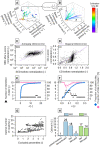Phenotype analysis of cultivation processes via unsupervised machine learning: Demonstration for Clostridium pasteurianum
- PMID: 35140556
- PMCID: PMC8811730
- DOI: 10.1002/elsc.202100114
Phenotype analysis of cultivation processes via unsupervised machine learning: Demonstration for Clostridium pasteurianum
Abstract
A novel approach of phenotype analysis of fermentation-based bioprocesses based on unsupervised learning (clustering) is presented. As a prior identification of phenotypes and conditional interrelations is desired to control fermentation performance, an automated learning method to output reference phenotypes (defined as vector of biomass-specific rates) was developed and the necessary computing process and parameters were assessed. For its demonstration, time series data of 90 Clostridium pasteurianum cultivations were used which feature a broad spectrum of solventogenic and acidogenic phenotypes, while 14 clusters of phenotypic manifestations were identified. The analysis of reference phenotypes showed distinct differences, where potential conditionalities were exemplary isolated. Further, cluster-based balancing of carbon and ATP or the use of reference phenotypes as indicator for bioprocess monitoring were demonstrated to highlight the perks of this approach. Overall, such analysis depends strongly on the quality of the data and experimental validations will be required before conclusions. However, the automated, streamlined and abstracted approach diminishes the need of individual evaluation of all noisy dataset and showed promising results, which could be transferred to strains with comparably wide-ranging phenotypic manifestations or as indicators for repeated bioprocesses with clearly defined target.
Keywords: Clostridium pasteurianum; automated fermentation analysis; phenotype analysis; process monitoring; unsupervised learning.
© 2021 The Authors. Engineering in Life Sciences published by Wiley‐VCH GmbH.
Conflict of interest statement
The authors have declared no conflict of interests.
Figures






References
-
- Jordan, M. I. , Mitchell, T. M. , Machine learning: Trends, perspectives, and prospects. Science 2015, 349, 255–260. - PubMed
-
- Kumar, Y. , Kaur, K. , Singh, G. , Machine learning aspects and its applications towards different research areas, 2020 International Conference on Computation, Automation and Knowledge Management (ICCAKM), Dubai, United Arab Emirates, 09.01.2020 ‐ 10.01.2020, IEEE, 2020, pp. 150–156.
-
- Volk, M. J. , Lourentzou, I. , Mishra, S. , Vo, L. T. , et al. Biosystems design by machine learning. ACS Synth. Biol. 2020, 9, 1514–1533. - PubMed
-
- Wu, J. , Zhao, Y. , Machine learning technology in the application of genome analysis: A systematic review. Gene 2019, 705, 149–156. - PubMed
LinkOut - more resources
Full Text Sources
Research Materials
